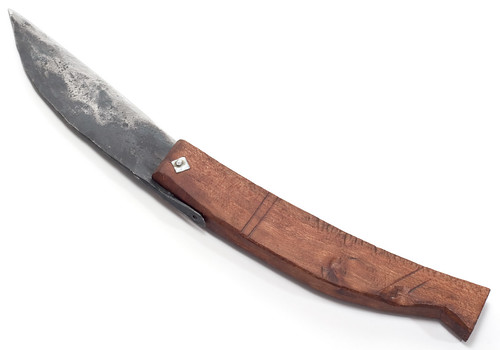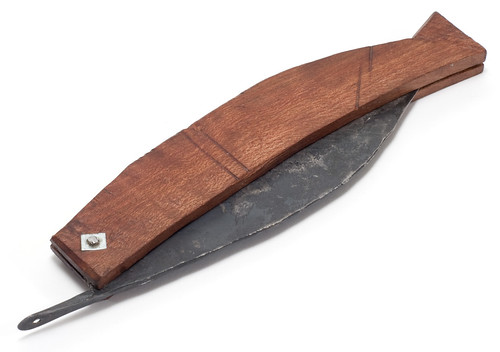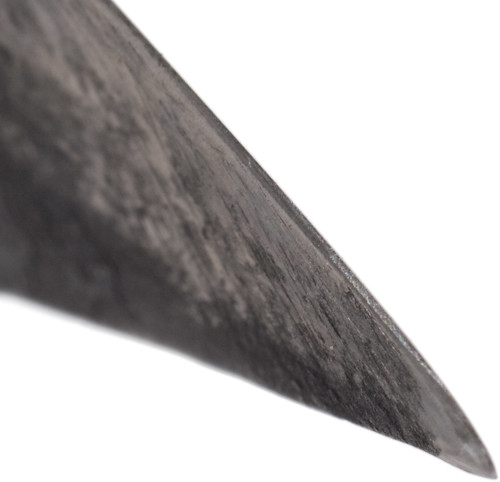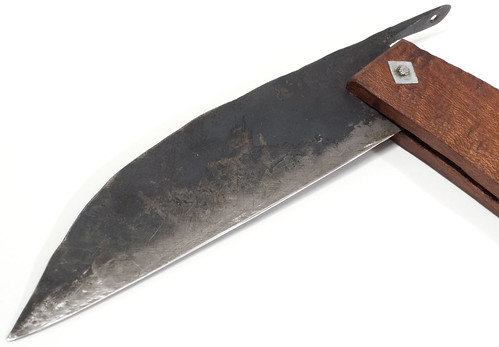The other day I wrote about a knife switch that might actually be an antique.
Today, allow me to present a knife that could be 2000 years old!
It's not, though. It was probably beaten out of a bit of old leaf spring or something by some bloke in China only a few months ago.
It's about 235mm (9.25 inches) long when open, and cost me $AU11.50 delivered (about $US10.50, as I write this) from eBay dealer "The Medieval Shoppe" here in Australia. Here they are on ebay.com; here's a search that finds this "Rustic Foldable Iron Knife" in their ebay.com.au store (if they currently have any to sell), and here it is on ebay.com.
The wood of the handle was a bit rough and splintery, so I sanded it a little and applied some home-made beeswax polish.
The blade came with a usable edge on it. I straightened the edge a bit on a steel, then touched it up with my fancy sharpening doodads. It took longer than usual to remove a tiny amount of material, so the blade is probably pretty high-carbon steel. I wouldn't be surprised if there's a lot of variation in the steel used to make these things, though.
(I cordially invite readers to start a religious war in the comments about What The One True Knife-Sharpening System is. I'll start: If you're a beginner and/or clumsy, get a sharpening kit with some sort of angle guide, like the CRKT Slide Sharp or, for blunter blades that need more material removed, a Gatco sharpening kit.)
Even without extra sharpening, this slightly-mad-slasher-looking thing's not just a bit of renaissance-faire costume kit. It's a perfectly practical tool, with a nice slim blade profile that makes it good for slicing tasks, though not a great choice for really heavy cutting, and no use at all for prying things open. And if you were to hop in your time machine with it and go back to the Roman Republic, nobody would find it particularly remarkable.
Well, actually I suspect the cap on the hinge rivet may be a bit of aluminium or stainless steel, which'd be a giveaway if someone examined the knife closely. But apart from that, this is a decent ancient replica.
(You could be onto a nice little earner there, actually. Scour handle and blade with dirt for a while, soak it in wine, soak it in oil, put it in a low oven for a little while, then bury it in the garden and water it daily for a week. And then dig it up and put it on eBay with a $500 reserve as Roman Pocket Knife Miraculously Preserved In Peat Bog. Just hope they don't carbon-date the wood.)
More intelligent readers may have figured out, from this, that folding pocket knives have been around for a surprisingly long time. Fixed-blade knives are stronger (provided they have a decent-sized tang), and simpler, and so have always been much more common. But the ancient Romans did indeed have folding pocket knives - some of quite sophisticated design.
The ancient folding knives, and indeed every known folding knife until about the 15th century, don't "lock". The blade is only held open, or closed, by friction between itself and the handle. This design makes it easy for the knife to close unexpectedly and seriously injure you if you push the blade hard into something (or someone), or if you're cutting something and the blade jams on a push stroke. A simple friction-joint knife can also come open in your pocket; hilarity may ensue.
For this reason, it's now possible to get a variety of Swiss Army knives (find more with the SOSAK "SAK Selector"!) that have a proper lock for their main blade, and not just the standard "slipjoint" arrangement that resists opening or closing of the blade, but doesn't positively lock the blade in either position.
(And yes, I am aware that some law-and-order geniuses in the UK decided to one-up the similar geniuses here in Australia and make it illegal to carry any knife with a locking blade in a public place, unless you have a "good reason". The list of acceptable "good reasons" does not appear to include "not wanting to cut my own fingers off, or stab myself in the scrotum while running for a bus".)
I wouldn't be surprised if someone 2000 years ago came up with at least a simple locking mechanism for a folding knife - like the rotating collar on the classic Opinel knife, for instance. A sliding ring, a peg that goes through holes in the handle and a slot in the blade; there are lots of possibilities that wouldn't require the precision fabrication techniques and tough steels upon which modern locking knives depend. But if someone did come up with a locking folder in 100 BC, it apparently didn't catch on.
(It's possible that many such knives were made, but didn't survive to the present day. Iron and steel items of all sorts are hard to find in archaeological digs, because iron easily rusts away to nothing over time, leaving archaeologists puzzling over the stain the rust left, and whatever parts remain, to figure out what the now-lost iron parts looked like. Older bronze-bladed knives and swords often fare a lot better. Early iron blades were actually clearly inferior to the bronze alternatives; iron was much more common than the copper-and-tin used to make bronze, but until we figured out how to make proper steel, iron swords were made of wrought iron. That material makes dandy door hinges, but lousy blades.)
My replica has a neat pseudo-lock system, though:
There's a flattened spike on the back of the blade that stops it from opening too far, and is also easy to grip when you grip the handle, and thereby prevent the blade from closing. It's not a real lock, and it sticks out awkwardly when the knife is closed, but as a safety feature it's a lot better than nothing.
(The spike also has a little hole in it, through which you could tie a lanyard.)
Making your own knife, often from some cast-off piece of steel like an old file or a railroad spike, is a popular simple metalworking/blacksmithing project. I think a lot of people are put off the idea, though, by thinking they have to make something that's somewhere near modern commercial quality, or at least as good as a Douk-Douk or K55K.
You don't, though. You can make a knife like this with basic hand tools, a gas stove and the very cheapest of eBay Anvil-Shaped Objects, if you've already got a chunk of steel.
Or you can just buy one, of course. Either way, it's another very satisfying object.




8 January 2010 at 1:34 pm
>You could be onto a nice little earner there, actually.
At last! You finally give your readers a useful commercial idea that isn't a complete and utter scam! Well, not totally anyway...you're only parting fools from their money, which has already been successfully done before anyway (can anyone spell 'audiophile'?).
8 January 2010 at 2:20 pm
I've got a beautiful knife my sister (the vegetarian) made me - lovely wood and pattern-welded metal handle, but the blade is quite heavy and shaped like a hunting knife. Since I don't even cook meat, let alone butcher deer in the woods, I'm always at something of a loss for appropriate uses. I mean, it does a credible job of chopping garlic, but I can get by with my cleaver for about 90% of my kitchen cutting tasks, and a paring knife pretty much covers the rest. (The ulu knife my parents gave me is even harder to find uses for, but at least I'll be ready if ever I need to make pemmican.)
8 January 2010 at 6:08 pm
i actually rather enjoy going to ren fairs, it about the only time i get to show off my sword collection without inviting friends to com over for a visit. to that end i have purchased a few things that i would have otherwise passed on, because they really have no use outside of costuming. a knife like this would be awesome. let me know if you find any authentic looking/functioning crossbows. i need one for my slayer costume. . .
anyway! if you want a guy who does good knife reviews i would recommend you check out the nutnfancy project on youtube.
http://www.youtube.com/user/nutnfancy
my gf says he is like watching an infomercial, and i do admit he can be very slow to get to the point, but he has a lot of cool things reviewed, and his experiences generally line up with mine as far as implementation goes. . . so check it out!
as to the knife sharpening, get yourself a good diamond file. something decently fine. i actually use the file on my leatherman to sharpen most of my knives, as it is more convenient than my knife care kit (also diamond file, its more consistent than stone, and does not really wear out). if i want a really nice edge (for the kitchen cutlery say) then i have to get the kit out, but for your standard utility edge the leatherman file works wonders. (it takes practice to get it right, learn on a blade you don't love.)
8 January 2010 at 6:13 pm
hehe, nutnfancy did a knife sharpening video, forgot about that.
http://www.youtube.com/user/nutnfancy#p/u/334/KDS_7AdcsAc
just for the record, i tried doing it this way, i don't like it. but if it works for you, and gets the blade sharp, then your not doing it wrong. so much about sharpening is just finding the way that is mos consistent for you.
8 January 2010 at 8:15 pm
I picked up a similar knife from Lee Valley. It's a really nice knife and it's wickedly sharp. Very good all-around knife and it works very well for opening plastic packages and such. Just need to be careful with it
http://www.leevalley.com/wood/page.aspx?c=1&p=51165&cat=1,51222&ap=1
8 January 2010 at 8:58 pm
Hmm, turns out I've got a K55K clone here. Doesn't have the cat or "K55K" engraving, and says "Toledo Australia" one one side of the blade, so I doubt it's a genuine german one... :-D It needs some work, though - the lock doesn't actually lock any more - a bit of pressure on the back of the blade will slip the lock and close the blade. I've nearly sliced my fingers once or twice because of that, but after a bit of stone work, it's certainly nice & sharp! (Great for opening blister packs, I must say!)
9 January 2010 at 11:52 am
After visiting the British Museum's Roman galleries, and then Pompeii (as well as the old bits of Rome), I was left with the distinct impression that the Romans were pretty much your average people of today, with the gas and electricity cut off, and a slightly quirky taste for extremely violent sports.
It was astonishing how many of their daily items look pretty much like they were made 80 years ago rather than somewhat more than 2,000.
Right down to toy sets with soldiers and chariots for the boys, and little dolls houses for the girls, all of which looked pretty cool even today.
The really impressive piece of culture I saw in Pompeii was a corner fast-food / pub just near the forum in the middle of town. It had what could only be called a pizza-oven that looked like it was from Pino's in Crows Nest circa 1960, and a brilliantly simple wine amphora refrigeration system built into the counter / bar top. You could easily imagine the crowd just before sundown after a hot day's trading at the Forum, all gathered round with a slice of Napoli's finest in one hand and a cup of cool wine in the other, gossiping about whether those funny dark clouds on the mountain would push the wine price up or down.
11 January 2010 at 3:15 pm
The thing that really struck me about Pompeii is that there is still Graphiti that rings true today.
http://www.pompeiana.org/Resources/Ancient/Graffiti%20from%20Pompeii.htm
The knife itself is great; I'm a sucker for anything old or an old design still in common use or that can still be pressed into service without much trouble. I'd pay good money for a digital conversion kit for a film SLR, and I suspect others would as well.
17 January 2010 at 5:27 am
One of the best and simplest locking mechanisms is found in the Balisong/Butterfly knife. By dint of its design it can't close on you while you're using it. Of course, they're illegal here (i think the arbitrary rule is that anything that can be opened using just gravity is illegal) even though you can have folders that open just as quickly and can be much larger than your average balisong. Law-types often cite "gang-related use" and such when trying to defend these stupid regs. Personally, i don't see why they can't just make the action of threatening or assaulting a person with a knife (or anything else) illegal, and leave what you choose to carry in your pockets (or simply have in your own home!) the hell out of it.
I happened to pick up a cheap balisong many years ago here in Perth when they were still sold in army surplus stores. A couple years ago i started watching CutleryLover's youtube tutorials (he also has great "Dan-level-of-detail" reviews) on how to flip them, and now i can do a few basic/intermediate moves with my old cheapo, which is quite fun, although i wish i could import a Benchmade 42 (ye olde benchmark for quality balisong) for proper action and weight and a latch that doesn't get in the way. Found this awesome guide to building your own from scratch, including oil quenching/tempering, but it's a bit involved.
17 January 2010 at 8:44 am
The trouble is, unless we're talking about big-ticket items like alcohol or tobacco, there's normally a larger group of people willing to cast their vote for a politician who intends to ban X object than there are people who will expressly vote for someone else. Amassing a collection of views that the "Won't somebody think of the children" types will single-issue vote on is rarely a bad thing politically.
/politics
I've considered trying my hand at hammering out a knife before. But Dan's exactly right about getting put off by be need for quality. Every time I've considered it the planned complexity has spiralled out of control until it didn't seem like a beginner's project any more.
Recently I've seen some good info on grinding them out of old, thick sawblades (or similar). It dispenses with some of the bigger hurdles of actual "forging". This (part two here) seems pretty informative without being over complicated.
29 December 2010 at 10:19 am
How interesting! I actually like the rustic look it has; that's what makes it interesting and unusual when set beside the thousands of other benchmade knives that look oh so similar. Though I wasn't surprised to hear it was useless basically; what else would I expect? If I bought this it would just be because it IS different. Thank you for sharing this post, it was fun to read and learn from.